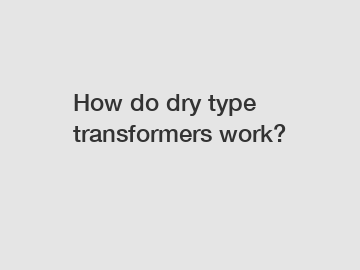Jan. 16, 2024
Electrical Equipment
How do dry type transformers work?
Dry type transformers, also known as cast resin transformers, work by using air or other gas as a cooling medium instead of liquid. Unlike their liquid-filled counterparts, dry type transformers do not require a protective enclosure or cooling equipment, making them suitable for various indoor applications. Let's delve into the details of how these transformers function, their benefits, and their impact on the industry.
The operation of dry type transformers can be explained by the basic principles of electromagnetic induction. When they receive alternating current (AC) from the electrical power system, the primary winding, which is energized, generates a varying magnetic field. This magnetic field induces a current in the secondary winding, thus transforming the voltage according to the turns ratio between the primary and secondary windings.

To withstand the high temperatures produced during the transformer's operation, dry type transformers use a combination of insulation materials. Layers of resin are applied to the windings, creating a barrier against moisture, dust, and other contaminants. The resin also acts as a coolant, dissipating the heat generated by the transformer. Ventilation openings in the transformer enclosure allow air to circulate and ensure efficient cooling. This self-cooling mechanism eliminates the need for additional cooling equipment.
The absence of liquid cooling agents in dry type transformers offers several advantages. First, it reduces the risk of leaks, which can be hazardous and lead to downtime and costly repairs. Moreover, the absence of flammable liquids enhances the safety of these transformers, making them suitable for installation in sensitive environments such as hospitals, schools, and commercial buildings.
In addition to their safety benefits, dry type transformers are more environmentally friendly. By eliminating liquid-filled tanks, these transformers reduce the risk of potential oil spills, minimizing environmental damage. They also consume less energy during operation since they do not require energy-intensive cooling systems or pumps.
The widespread use of dry type transformers has had a significant impact on various industries. For instance, their compact size and versatility make them an ideal choice for retrofits or upgrades in existing buildings with limited space. Additionally, they are often chosen as a reliable solution in areas prone to earthquakes or flooding, where the risk of liquid-filled transformers rupturing is higher.
Furthermore, the maintenance requirements of dry type transformers are lower compared to liquid-filled transformers. As there is no need for periodic oil testing and replacement, the overall operating costs are reduced. This cost-effectiveness has made dry type transformers increasingly popular in commercial and industrial applications.
In conclusion, dry type transformers operate by using air or other gases as a cooling medium and are free from liquid coolant. The absence of fluids enhances their safety, environmental sustainability, and overall cost-effectiveness. These transformers have revolutionized various industries by providing reliable and efficient electrical power solutions in diverse applications.
Are you interested in learning more about low voltage(lv) mns gcs withdrawable type switchboard assemblies, low voltage power control cabinet, industry low-voltage power distribution cabinet? Contact us today to secure an expert consultation!
Previous: Should I use OPGW or ADSS?
If you are interested in sending in a Guest Blogger Submission,welcome to write for us!
All Comments ( 0 )